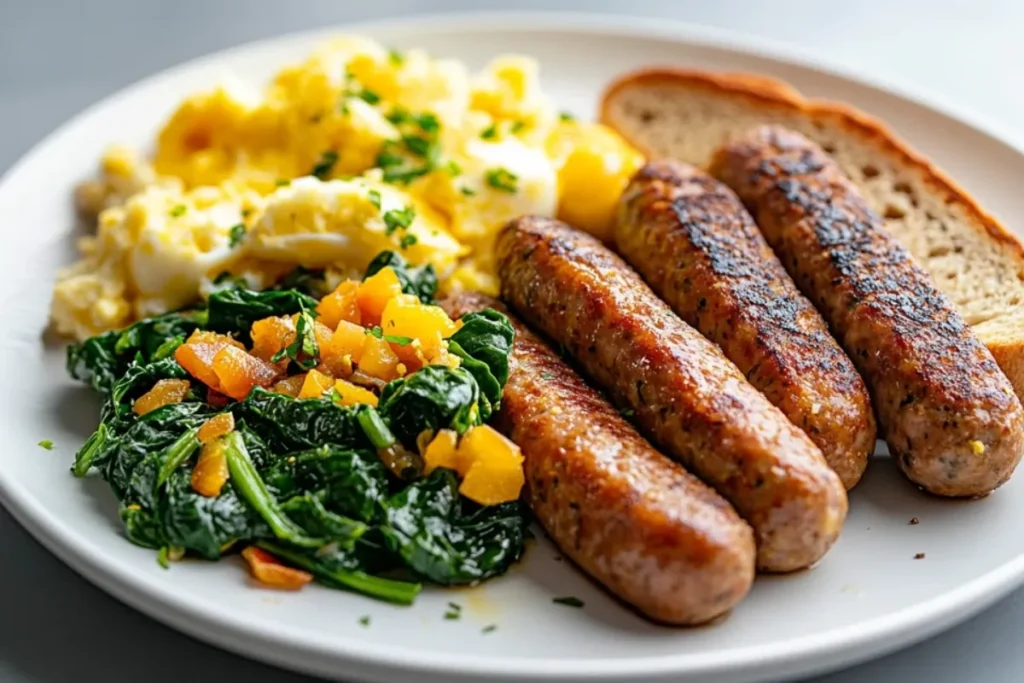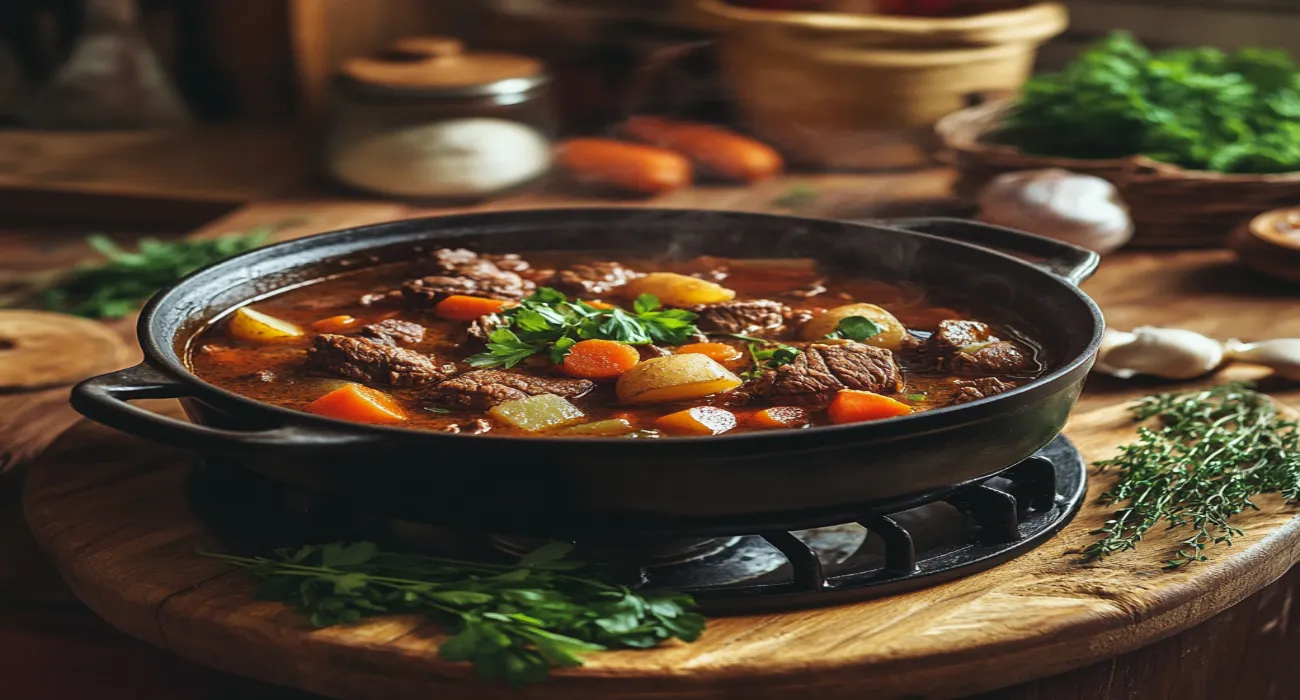Turkey sausage has become a popular choice for people seeking healthier alternatives to traditional pork sausage. But have you ever stopped to wonder: Is turkey sausage 100% turkey? This article dives into that very question, exploring the ingredients, labeling practices, and what to look for when buying turkey sausage. We’ll also cover its nutritional profile, health benefits, common additives, and even share tips on choosing the best options and recipes to try at home. So, whether you’re a turkey sausage enthusiast or just curious, let’s uncover the facts.
For quick, flavorful recipes, explore our collection of Easy Chicken Recipes for Dinner. They complement turkey sausage perfectly!
What is Turkey Sausage?
Introduction to Turkey Sausage
Turkey sausage is a flavorful meat product made primarily from ground turkey, seasoned with spices to mimic the taste of traditional sausage. It emerged as a popular alternative to pork sausage, particularly among those seeking a lower-fat and high-protein option. Over the years, turkey sausage has found its way onto breakfast tables, into hearty dinners, and even as a go-to ingredient in meal prep routines.
The appeal lies in its versatility and reputation as a “healthier choice.” However, despite its name, turkey sausage isn’t always as straightforward as it seems—sometimes, the product includes more than just turkey. We’ll explore this in greater detail in the following sections.
Common Uses of Turkey Sausage
Turkey sausage is beloved for its ability to adapt to various meals. It’s a staple in breakfast classics like omelets, sausage patties, and breakfast burritos. Beyond breakfast, it’s also used in casseroles, soups, and pasta dishes, offering a lean protein boost without overpowering other flavors. The flexibility of turkey sausage makes it an easy replacement for pork sausage in most recipes.
Interestingly, turkey sausage is available in multiple forms, including fresh, pre-cooked, and frozen varieties. Fresh turkey sausage is uncooked and requires preparation, while pre-cooked options offer convenience for those on the go.
Nutritional Overview of Turkey Sausage
Nutritionally, turkey sausage is often marketed as a leaner alternative to its pork counterpart. A typical serving contains fewer calories and significantly less fat. On average, a 2-ounce serving of turkey sausage has around 100-140 calories, 10-12 grams of protein, and about 7 grams of fat, depending on the brand and preparation method.
However, not all turkey sausage is created equal. Some varieties are packed with sodium and additives, which can negate the health benefits. Comparing labels and choosing minimally processed options is key to enjoying turkey sausage without compromising on health.
Curious about what goes into turkey sausage? Don’t miss our detailed guide, What Is Turkey Sausage Made Out Of?
Is Turkey Sausage 100% Turkey?
What Ingredients Are Found in Turkey Sausage?
When you think of turkey sausage, you probably assume it’s just ground turkey with spices, right? Well, not always. Most turkey sausages are made from a combination of ground turkey (often a mix of dark and light meat) and seasonings like salt, pepper, garlic, and herbs. However, some brands include additional ingredients to enhance flavor, texture, and shelf life.
Common additions include breadcrumbs, starches, or even soy protein, which act as fillers to reduce costs or improve consistency. Other ingredients like preservatives (e.g., sodium nitrate) are often added to extend the sausage’s shelf life. While these may not drastically alter the taste, they can impact the product’s overall healthiness.
Does Turkey Sausage Always Contain 100% Turkey Meat?
The short answer: not always. This is where the key question—Is turkey sausage 100% turkey—comes into play. In many cases, turkey sausage is primarily turkey, but it may also include small amounts of other meats or animal by-products. For instance, some brands might blend pork fat or other animal-derived fillers to enhance flavor or juiciness.
In the United States, labeling standards require manufacturers to list all ingredients. If a sausage product contains other meats or additives, they must appear on the label. Be on the lookout for terms like “mechanically separated meat” or “natural flavors,” which could hint at more than just turkey in the mix.
How to Identify if Turkey Sausage is 100% Turkey
Want to ensure you’re buying sausage made entirely of turkey? Start by carefully reading the ingredient list on the packaging. Look for products labeled as “100% turkey” or “all-natural turkey sausage.” These options typically avoid using fillers or added meats.
Pay attention to certifications like “organic” or “non-GMO,” as these tend to indicate cleaner ingredient lists. Avoid products with vague descriptions or overly long ingredient lists, as these often signal heavily processed options. Ultimately, knowing how to decode the packaging ensures you’re getting what you pay for—delicious, healthy turkey sausage.
Common Additives and Fillers in Turkey Sausage
What Are Fillers and Why Are They Used?
Fillers are non-meat ingredients added to turkey sausage to bulk up the product and reduce costs. Examples include breadcrumbs, cornstarch, soy protein, and even textured vegetable protein (TVP). These fillers are often used to improve the sausage’s texture, help it hold together during cooking, and make it more affordable for consumers.
While fillers might make the product cheaper, they can also dilute the protein content and add unnecessary carbs or allergens. If you’re aiming for a high-protein, low-carb diet, fillers could make turkey sausage a less appealing choice.
Preservatives in Turkey Sausage
Preservatives like sodium nitrate and sodium erythorbate are common in processed turkey sausage. These chemicals prevent spoilage, extend shelf life, and keep the sausage looking fresh and pink. However, there’s been ongoing debate about whether consuming nitrates in large quantities poses health risks, such as an increased risk of certain cancers.
For those looking to minimize preservatives, it’s best to opt for nitrate-free or minimally processed options, which are now available in many grocery stores. Organic turkey sausage, in particular, is a great choice for those avoiding chemical preservatives.
Artificial Flavors and Seasonings
Turkey sausage often gets its bold, savory taste from seasonings like sage, thyme, black pepper, and garlic. However, not all flavors come from natural sources. Some turkey sausages use artificial flavor enhancers, such as monosodium glutamate (MSG) or liquid smoke flavoring, to replicate a smoky or spicy taste.
These artificial additives may not sit well with everyone, especially those who are sensitive to processed foods. Checking the label for phrases like “all-natural flavors” or “no artificial ingredients” is a good way to steer clear of unnecessary chemicals.
How Turkey Sausage Compares to Other Sausage Options
Turkey Sausage vs. Pork Sausage
When it comes to comparing turkey sausage with pork sausage, there are key differences worth noting. Pork sausage is known for its rich, savory flavor and higher fat content, making it a favorite in many traditional recipes. On the other hand, turkey sausage is often chosen as a healthier alternative, thanks to its lean protein and lower calorie count.
A 2-ounce serving of pork sausage typically contains around 170-200 calories and 15-20 grams of fat, depending on the cut of pork used. By contrast, turkey sausage averages around 100-140 calories and 7 grams of fat per serving. This makes turkey sausage an appealing option for those looking to cut back on saturated fats without sacrificing flavor.
However, turkey sausage has a slightly milder taste compared to pork, which some find less satisfying. To make up for this, turkey sausage is often heavily seasoned with spices like sage, fennel, or paprika to boost its flavor profile. While pork sausage is more indulgent, turkey sausage is a better choice for those aiming to balance health and taste.
Turkey Sausage vs. Chicken Sausage
At first glance, turkey sausage and chicken sausage seem almost identical in terms of nutrition. Both are lean protein sources with relatively low-fat content compared to pork sausage. However, turkey sausage is often slightly higher in protein, while chicken sausage tends to be slightly lower in sodium.
Taste-wise, chicken sausage is often lighter and has a more delicate flavor, making it ideal for recipes where you don’t want the sausage to overpower other ingredients. Turkey sausage, with its bolder seasoning, works better in hearty dishes like pasta or casseroles. Ultimately, the choice between turkey and chicken sausage depends on personal preference and the specific recipe you’re preparing.
Vegetarian Alternatives to Turkey Sausage
For those seeking a plant-based option, vegetarian sausage alternatives are becoming more popular. Brands like Beyond Meat and MorningStar Farms offer sausage products made from pea protein, soy, or other plant-based ingredients. While these options are lower in fat and cholesterol, they may not match turkey sausage’s protein content.
If you’re curious about swapping turkey sausage for vegetarian options, it’s worth experimenting with different brands to find one that suits your taste and dietary needs. These alternatives are especially useful for people following a vegetarian or flexitarian diet.
Health Implications of Eating Turkey Sausage

Is Turkey Sausage Actually Healthy?
Turkey sausage has earned a reputation as a healthier alternative to traditional sausages. But is it truly as good as it seems? The answer depends on the specific product you choose. In general, turkey sausage is a solid source of lean protein, providing about 10-12 grams of protein per serving. It’s also lower in saturated fats than pork sausage, which is beneficial for heart health.
That said, not all turkey sausage is created equal. Many store-bought options are loaded with sodium and preservatives, which can outweigh the health benefits of the lean meat. Sodium levels can range from 400-600 milligrams per serving, so it’s important to read labels carefully if you’re watching your sodium intake.
What to Watch Out For in Turkey Sausage
One of the main concerns with turkey sausage is its level of processing. Highly processed versions may contain additives, artificial flavors, or fillers that reduce its nutritional value. These ingredients can include anything from nitrates to enhance color to high-sodium seasonings that make the sausage taste more flavorful.
If you’re concerned about additives, opt for organic or nitrate-free turkey sausage. These versions are typically made with minimal processing and contain fewer chemicals. Alternatively, consider making your own turkey sausage at home to control what goes into it.
Healthier Turkey Sausage Alternatives
To make turkey sausage even healthier, look for options labeled “all-natural,” “organic,” or “100% turkey.” These tend to have cleaner ingredient lists and fewer preservatives. For an even more health-conscious option, consider preparing your own turkey sausage using ground turkey, fresh herbs, and spices.
Homemade turkey sausage not only gives you complete control over the ingredients but also allows you to experiment with flavors. You can keep it low in sodium, avoid fillers, and customize the spice blend to suit your preferences.
How is Turkey Sausage Made?
Sourcing and Processing Turkey Meat
The first step in making turkey sausage is sourcing quality turkey meat. Most commercial turkey sausage is made from a combination of light and dark turkey meat. In many cases, the meat comes from cuts that aren’t commonly sold as whole products, such as trimmings or parts of the turkey that are ideal for grinding.
Once sourced, the turkey is ground into a fine consistency to prepare it for mixing. Depending on the manufacturer, some turkey sausages use only 100% turkey, while others may include small amounts of other ingredients to improve texture or flavor. So, if you’re wondering, Is turkey sausage 100% turkey?, the answer often lies in checking the ingredient label for added fillers or by-products.
Seasoning and Flavoring Turkey Sausage
After the meat is ground, it’s mixed with a blend of spices and seasonings. Popular seasonings include garlic, onion, black pepper, sage, paprika, and fennel seeds. These spices not only add flavor but also mimic the bold taste of traditional pork sausage. Some manufacturers use artificial flavor enhancers, such as liquid smoke or MSG, to intensify the taste.
For specialty turkey sausages, additional ingredients may be added. For example, apple chunks or maple syrup can be mixed into sweet varieties, while red pepper flakes and cayenne are common in spicy options. This seasoning step is where turkey sausage gets its signature flavor, which is often preferred for lighter, healthier meals.
Packaging and Preservation
Once mixed and seasoned, the sausage is shaped into links, patties, or bulk packages. The final product is then vacuum-sealed or placed in airtight packaging to keep it fresh. Some turkey sausages are pre-cooked before packaging, making them convenient for quick meals. Others are sold raw and require cooking before eating.
Preservatives like sodium nitrates are often added to extend shelf life, though some brands offer nitrate-free and organic options for health-conscious consumers. If you’re concerned about additives, opt for these cleaner versions or prepare turkey sausage at home to ensure it’s truly 100% turkey.
Popular Brands and Types of Turkey Sausage
Top Turkey Sausage Brands in the Market
The turkey sausage market is packed with options, ranging from budget-friendly products to premium organic brands. Popular names like Butterball, Jennie-O, and Applegate are household staples, offering a variety of turkey sausage options. Butterball and Jennie-O focus on affordability and convenience, with products like frozen sausage patties and pre-cooked links.
Meanwhile, Applegate is a favorite for those seeking natural, organic, and nitrate-free options. Their turkey sausages are often labeled “100% turkey,” with no artificial flavors or preservatives, making them a great choice for health-conscious shoppers.
Specialty Turkey Sausage Options
Beyond the mainstream options, you’ll also find specialty turkey sausages tailored to different tastes and dietary needs. Gluten-free, low-sodium, and nitrate-free varieties are increasingly common, catering to people with specific health concerns.
Flavored turkey sausages are another exciting category. Maple-flavored turkey sausage, for instance, is perfect for breakfast dishes, while spicy varieties are great for adding a kick to soups and stews. Additionally, organic and locally made turkey sausages are growing in popularity, offering cleaner ingredient lists and supporting sustainable farming practices.
If you’re wondering, Is turkey sausage 100% turkey?, many premium and specialty brands prioritize transparency. These options often come with simple, easy-to-read ingredient lists, ensuring you know exactly what you’re eating.
How to Choose the Best Turkey Sausage
Understanding Labels and Claims
Choosing the best turkey sausage starts with reading the label carefully. Packaging often includes terms like “organic,” “all-natural,” or “100% turkey,” but what do these really mean? If you’re wondering, Is turkey sausage 100% turkey?, the answer often lies in these claims.
For instance, “100% turkey” typically means the sausage is made entirely from turkey meat, without any other meats or fillers. On the other hand, phrases like “natural flavors” or “seasoned with herbs” can sometimes mask the presence of artificial additives. Organic turkey sausage usually comes with stricter standards, such as no antibiotics, hormones, or artificial preservatives, making it a cleaner choice.
Key Factors to Consider When Buying Turkey Sausage
When selecting turkey sausage, prioritize the following factors:
- Ingredients: Look for products with simple, recognizable ingredients. The fewer fillers and preservatives, the better.
- Sodium Levels: Some turkey sausages can be surprisingly high in sodium. Choose low-sodium options to support heart health.
- Fat Content: Opt for turkey sausage labeled “lean” or “extra-lean” if you want to reduce calorie and fat intake.
In addition to these factors, consider your dietary needs. If you’re avoiding gluten, look for certified gluten-free turkey sausages. Those with food sensitivities or allergies should also check for common allergens like soy or dairy.
Recommended Tips for First-Time Buyers
If you’re new to turkey sausage, start with trusted brands like Applegate or Jennie-O. These brands often offer products that are free from unnecessary additives. Don’t forget to compare different types—fresh, pre-cooked, or flavored—to find the one that works best for your recipes.
Wondering if turkey sausage is a healthy choice? Read our article, Is Turkey Sausage Actually Healthy?, to learn more.
Recipes and Cooking Ideas Using Turkey Sausage
Simple Turkey Sausage Breakfast Recipes
Turkey sausage is a breakfast favorite, and for good reason—it’s tasty, filling, and versatile. For a quick and healthy breakfast, try sautéing turkey sausage patties and serving them alongside scrambled eggs and whole-grain toast. Or, mix cooked turkey sausage crumbles into an omelet with spinach and tomatoes for an easy, protein-packed start to your day.
For a sweet and savory twist, maple-flavored turkey sausage pairs perfectly with pancakes or waffles. Add a drizzle of maple syrup for extra flavor.

Dinner Recipes Featuring Turkey Sausage
Turkey sausage shines in hearty dinner dishes too. One popular option is turkey sausage pasta. Toss cooked turkey sausage slices with whole-wheat pasta, roasted vegetables, and marinara sauce for a comforting yet healthy meal.
For colder evenings, turkey sausage works wonderfully in soups and stews. Consider making a spicy turkey sausage and kale soup with white beans, or try a turkey sausage chili for a flavorful, protein-packed dish. The possibilities are endless, and turkey sausage’s mild flavor complements a wide range of ingredients.
Tips for Grilling or Pan-Frying Turkey Sausage
When cooking turkey sausage, it’s important to maintain moisture. If pan-frying, cook over medium heat and add a splash of water or broth to prevent it from drying out. For grilling, brush the sausage with olive oil to lock in flavor and prevent sticking.
No matter how you prepare it, turkey sausage is a versatile ingredient that can elevate any meal. If you’ve been asking, Is turkey sausage 100% turkey?, knowing how to cook and pair it ensures you’re making the most of this lean, delicious protein.
Looking for more turkey sausage inspiration? Check out our dedicated post on Turkey Sausage for ideas and tips!

